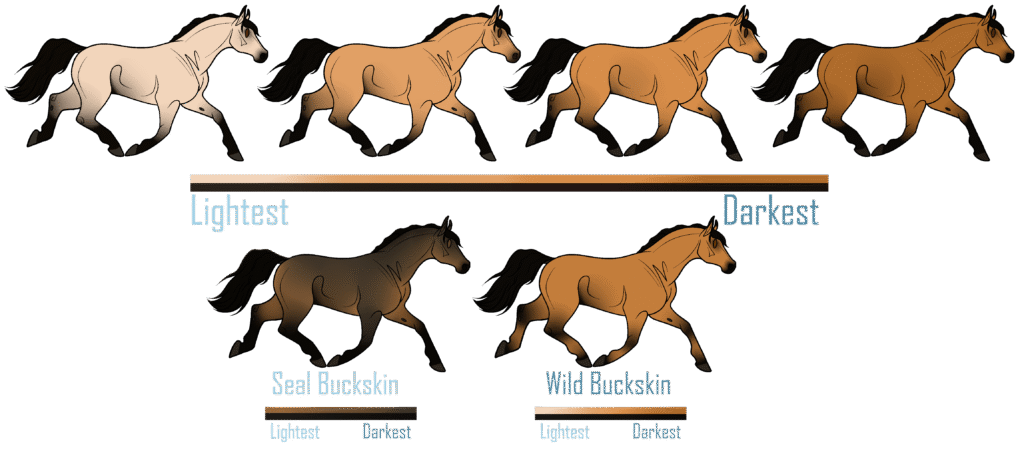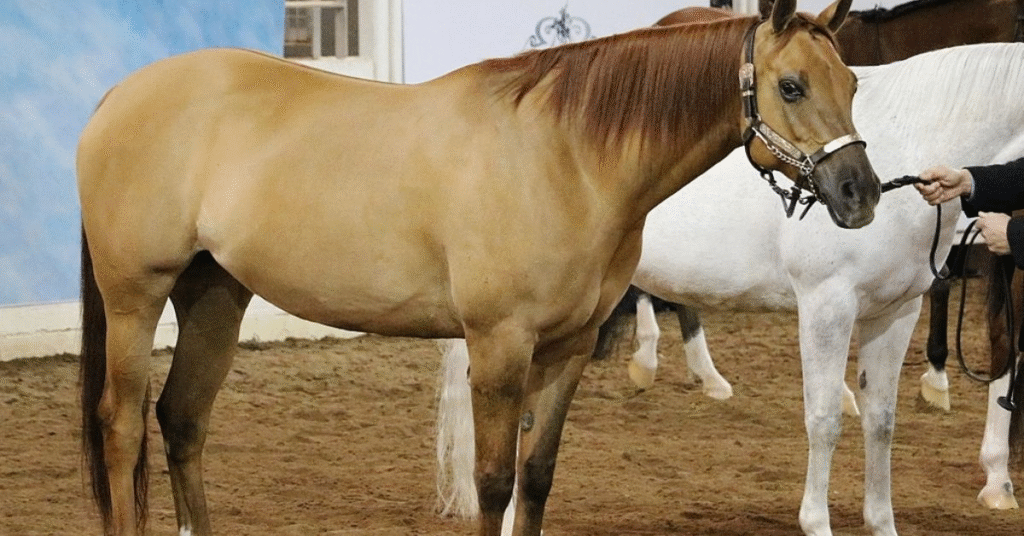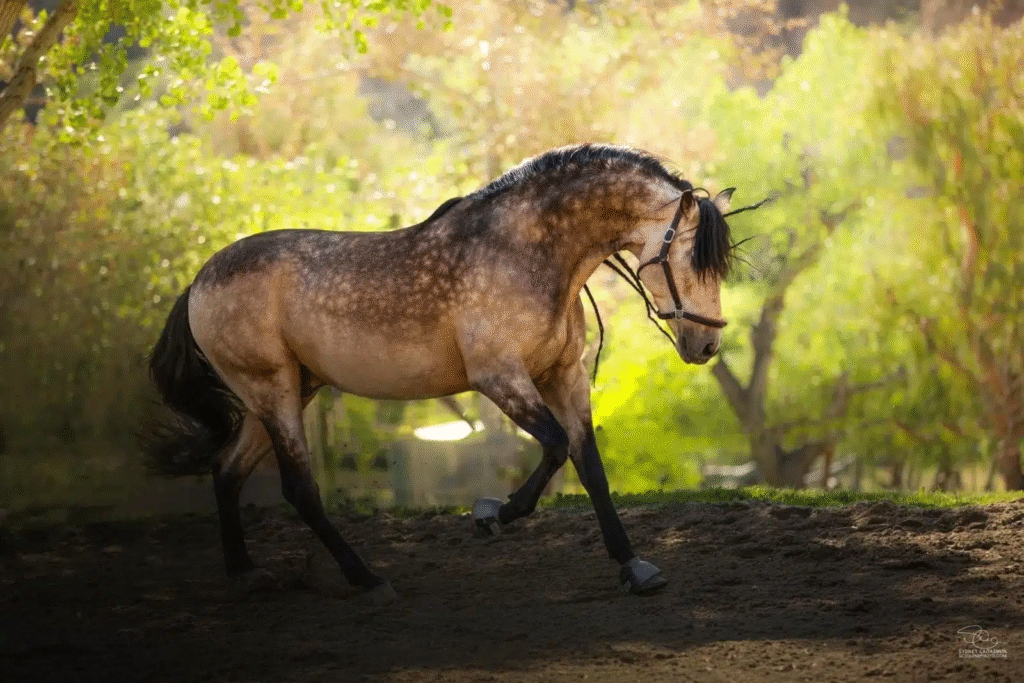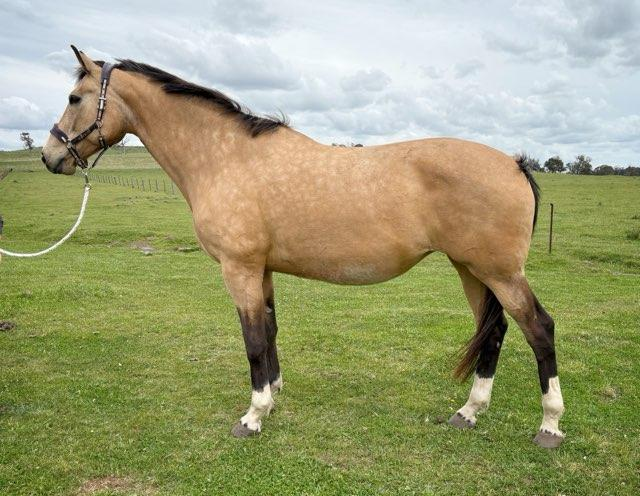Imagine the elegance of an Arabian horse—refined features, flowing mane, unmatched stamina—now draped in a warm golden coat with black-tipped legs and a smoky mane. That’s a Buckskin Arabian stallion. Rare, majestic, and catching the eye of breeders and horse lovers everywhere.
History of Arabian Horses & Color Genetics

Arabians are one of the oldest and most revered horse breeds in the world, valued for their intelligence, endurance, and spirit. Historically bred in the Middle East, these horses were primarily solid-colored—chestnut, grey, bay, or black. The buckskin shade, however, isn’t native to purebred Arabians. So how did we get here? Through strategic and careful color-cross breeding.
Understanding the Buckskin Coat

What is a Buckskin Horse?
Buckskin refers to a coat color—not a breed. It’s the result of a bay base coat diluted by a single cream gene, giving the horse a tan to gold body, black mane, tail, and lower legs.
The Science Behind the Buckskin Color
Buckskins have one copy of the cream dilution gene (N/Cr) and a bay base (A/A or A/a + E/E or E/e). This gene lightens the body color while keeping the points (mane, tail, legs) dark. It’s a dominant gene, meaning only one parent needs to pass it down.
Why Buckskin is Rare in Arabians
Purebred Arabians do not carry the cream gene. To create a Buckskin Arabian, breeders cross a pure Arabian with a cream gene carrier—usually breeds like Quarter Horses, Andalusians, or American Saddlebreds. This makes buckskin Arabians either “half Arabians” or Arabian Warmbloods—not purebreds.
The Arabian Horse Lineage

Purity and Pedigree in Arabian Horses
Arabian horses are often celebrated for their pure lineage. Breeders strive to maintain bloodlines that date back centuries. This purity also limits color options.
Influence of Color Breeding on Bloodlines
Color breeding, such as attempting to get a buckskin, often shifts the focus from performance and conformation to aesthetics. However, with proper breeding ethics and standards, it’s possible to strike a balance.
The Buckskin Arabian Stallion

Physical Features and Temperament
These horses inherit the elegant frame of Arabians: dished face, high tail carriage, and compact body. Add a gleaming buckskin coat, and you’ve got a horse that turns heads. Their temperament is typically smart, spirited, and people-oriented.
Performance and Versatility
Buckskin Arabians can excel in endurance, dressage, showmanship, and even pleasure riding. Their stamina and intelligence make them versatile, while their looks bring show-ring appeal.
Buckskin Arabian vs Traditional Arabian Stallions
Traditional Arabians might be more accepted in purebred competitions. However, buckskin Arabians—especially half Arabians—often steal the spotlight in open classes due to their rare beauty.
Buckskin Half Arabian Horses

What is a Half Arabian?
A Half Arabian is the result of crossing a registered Arabian horse with another breed. To be registered as a Half Arabian, one parent must be purebred Arabian.
Popular Crossbreeds to Achieve Buckskin Color
- Arabian × Quarter Horse
- Arabian × American Saddlebred
- Arabian × Morgan Horse
These crosses often bring color, structure, and added calmness.
Benefits of Owning a Buckskin Half Arabian
You get the best of both worlds—Arabian elegance and energy mixed with the strength, temperament, or size of the other breed. Plus, their coat color is always a conversation starter!
Breeding for Buckskin Arabians

Challenges in Breeding True Buckskin Arabians
You can’t breed two buckskins and guarantee another buckskin. The cream gene doesn’t work that way. You need careful genetic planning and a good understanding of coat color inheritance.
Role of DNA Testing and Genetic Mapping
Modern breeders rely on color DNA testing to ensure the presence of desired genes like cream, agouti, and black. This helps increase the odds of producing a buckskin foal.
Ethical Considerations in Color Breeding
Some argue color breeding prioritizes aesthetics over soundness or personality. Responsible breeders always consider health, conformation, and performance over mere color.
Buying a Buckskin Arabian Horse

What to Look For in a Buckskin Arabian for Sale
- Verified parentage (especially if you’re buying a Half Arabian)
- Coat color DNA testing results
- Registration papers (Arabian Horse Association, Half-Arabian registry, etc.)
- Health, conformation, and training history
Tips for Verifying Authenticity and Pedigree
Always request to see papers, test results, and, if possible, meet the horse in person. Use reputable breeders and ask about both sire and dam lines.
Where to Find Buckskin Arabian and Half Arabian Horses for Sale
- Arabian Horse Association Classifieds
- Equine.com or DreamHorse.com
- Specialized Buckskin Horse Breeders
- Local and national Arabian shows and expos
Buckskin Arabians in Shows and Competitions

Are Buckskin Arabians Eligible for Arabian Horse Shows?
Purebred-only shows generally exclude buckskin-colored horses unless the registry allows for colored variants. However, Half-Arabians have their own show circuits.
Their Place in Open and Half-Arabian Competitions
Half-Arabians can compete in many disciplines—from halter to hunter pleasure—and are often judged favorably for their unique appeal.
Famous Buckskin Arabians

Notable Stallions in History
Though rare, a few standout Half Arabians have gained fame in the show ring and breeding world. Names vary by region and registry.
Success Stories in Performance Circles
Several buckskin Arabians have found success in western pleasure, trail, and even dressage—proving their ability goes far beyond their beautiful color.
Caring for a Buckskin Arabian

Grooming for Lighter-Colored Horses
Buckskins often show dirt more clearly. Frequent brushing, coat conditioners, and fly sprays help maintain their stunning appearance.
Nutrition and Exercise Needs
Their diet and exercise needs are similar to other Arabians: balanced feed, plenty of turnout, and regular mental stimulation to avoid boredom.
The Market Demand and Value

Pricing Trends in Buckskin Arabians
Prices for Buckskin Arabians or Half Arabians range widely—from $7,000 to $30,000+—depending on training, pedigree, and color intensity.
Why They Are So Desirable Today
It’s the mix of rarity, beauty, and Arabian spirit that makes them a prized choice for both novice and experienced horse owners.
Conclusion
The Buckskin Arabian stallion is more than just a beautiful horse—it’s a symbol of thoughtful breeding, genetic wonder, and the enduring allure of the Arabian breed. Whether you’re a seasoned breeder or a passionate rider, these golden beauties offer a rare combination of form, function, and flair.
FAQs
Are Buckskin Arabian Horses Purebred?
No, since purebred Arabians cannot carry the cream gene, buckskin Arabians are typically Half Arabians.
How Rare Are Buckskin Arabians Globally?
Extremely rare. Only a small percentage of Arabian crosses produce buckskins due to the specific gene requirements.
Can You Register a Half Arabian Buckskin?
Yes, through the Arabian Horse Association’s Half-Arabian registry or other regional breed associations.
Do Buckskin Arabians Have Different Temperaments?
Their temperament aligns more with the Arabian breed, though the crossbreed may slightly alter personality traits.
What is the Lifespan of a Buckskin Arabian?
With proper care, they can live 25–30 years, similar to other Arabian or crossbred horses.







